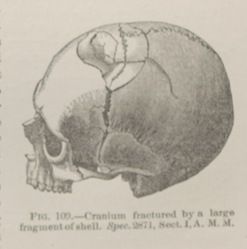Title: X——
Source text: Surgeon General Joseph K. Barnes, United States Army, The Medical and Surgical History of the War of the Rebellion. (1861–65.), Part 1, Volume 2 (Washington, D.C.: Government Printing Office, 1870), 213.
Civil War Washington ID: med.d1e14723
TEI/XML: med.d1e14723.xml
CASE.—X——, an unknown Confederate, was brought into Lincoln Hospital on July 17th, 1864, in an ambulance train conveying the wounded, abandoned by General Early, in front of Fort Stevens. According to the official reports, the Confederates retired from before Washington on the night of July 12th. The stretcher-bearers reported that this man was found nearly three miles north of Fort Stevens, unconscious and unable to articulate, with a terrible wound over the vertex, and that near by him was the huge fragment of shell supposed to have inflicted the injury, and to have been fired from one of the eleven-inch guns at Fort Stevens. It appears almost incredible that the patient could have survived so long. He died two hours after his admission to hospital. On the following day an autopsy was made. Over the anterior superior angle of the left parietal bone there was an extended scalp wound. On reflecting the scalp, multiple depressed fractures of the vault of the cranium came into view. The point of greatest depression is an inch to the left of the median line, near the coronal suture. The depressed fragments measure from before backward two inches, and from right to left three inches, and involve both parietals and the os frontis. A fissure runs through the squamous portion of the left temporal, and all the sutures of this bone are separated. The autopsy was made and the specimen was forwarded by Acting Assistant Surgeon Henry M. Dean. It is figured in the adjacent wood-cut, and much better in the Surgical Photograph Series¹ of the Army Medical Museum.
¹ Photographs of Surgical Cases and Specimens. Prepared, by direction of the Surgeon General, by Brevet Lieutenant Colonel George A. Otis, Assistant Surgeon, U. S. A. Washington, 1866. 5 Vols., Quarto, Vol. I, Case 3.
